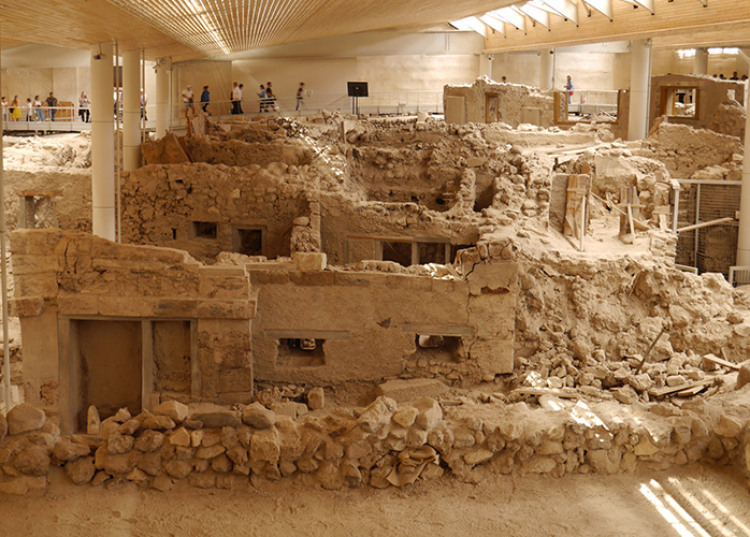Characterised by humans’ use of metal tools and weapons, the Bronze Age was a period of history stretching from around 3300 BC to 1200 BC. It saw new inventions and innovations such as writing systems, the wheel, pyramids and canals.
Large cities, and kingdoms ruled by a single ruler, also became more prevalent during the era. While many such sites have been subsumed by the passage of time and the work of later civilisations, Bronze Age relics have nonetheless been preserved across the globe.
Here are 10 of the world’s most significant Bronze Age locations and landmarks.

1. Hili Archaeological Park
The Hili Archaeological Park is a Bronze Age site located just north of Al Ain in the United Arab Emirates. It was in use in the 3rd millennium BC and its ruins include settlements, tombs, and a later Iron Age falaj (irrigation channel).
Today, the Hili Archaeological Park has been sculpted as both a historic site and public garden and is a popular place to relax and explore for both tourists and locals. A highlight is the Hili Grand tomb with its meticulously cut stone blocks and animal/human images at the entrances dating back to the Umm Al-Nar culture.

2. Su Nuraxi di Barumini
Su Nuraxi di Barumini is a prime example of one of Sardinia’s many nuraghe, a form of mysterious stone structures. Little is known about the nuraghe, except that they are thought to have been built from the Bronze Age to the Early Iron Age (circa 1500-800 BC) by the island’s inhabitants as a form of defence.
Today, Su Nuraxi di Barumini is still an impressive site, the main highlight of which is its central stone tower. Many other structures have been identified at Su Nuraxi di Barumini, including homes, a theatre and temples, all seemingly intertwined in what looks like a mosaic.

3. Jabel Hafit Tombs
The Jabel Hafit Tombs, with their distinctive domed-beehive shape composed of stacked natural and edged stones, date back some 5,000 years to the ‘Hafeet Period’ (3200 to 2700 BC).
At the site, there are approximately 500 tombs in all with rare skeletal remains in the tombs. Workers presume as many as ten individuals were originally buried in any particular tomb.

4. Tanum Rock Carvings
At least 350 groups of distinct rock art make up the UNESCO-listed Tanum Rock Carvings, a collection of Bronze Age etchings found in the area around the modern town of Tanumshede in Sweden. They date from around 1700 BC to 500 BC.
The Tanum Rock Carvings are spread out over a wide area. Within the heritage area there are around 600 rock carvings boasting tens of thousands of images. 4 of the key groups of carvings have parking areas, footpaths and information boards: Vitlycke, Aspeberget, Litsleby and Fossum.

5. Akrotiri
Akrotiri is a beautifully preserved ancient site in Santorini, famed for its incredible frescos and its connection with the Minoans. Inhabited as early as the 4th millennium BC – some say earlier – it then thrived and grew into a larger settlement measuring up to 20 hectares in the next millennium, during the Bronze Age.
The stunning ruins of Akrotiri still stand, a testament to the sophisticated urban settlement which once existed there. The buildings are not only multi-story, but many of them contain vivid frescoes of various themes. This excellent state of preservation has earned it the moniker of the ‘Minoan Pompeii’.

6. Great Orme Ancient Mines
The ancient copper mines discovered below the Great Orme – a prominent limestone headland on the north coast of Wales – date back over 4,000 years to the Bronze Age. Uncovered in 1987, it is thought to be one of the largest known prehistoric mines in the world. It is thought the mines remained in use until they were abandoned around 600 BC.
Today, visitors can take a tour of the tunnels and find out more about the history of the Great Orme Mines in the visitors’ centre.

7. Qatna Archaeological Park
Qatna Archaeological Park in Tell Mishrifeh in Syria houses the ruins of what was the thriving ancient Mesopotamian city of Qatna. Known to have first been occupied in the 3rd millennium BC, Qatna’s location on a crossroad between the Mitanni empire and the ancient Egyptians allowed it to flourish. And in the period between 1600BC and 1200BC, the Late Bronze Age, it grew to become a local kingdom.
The Royal Palace is perhaps the highlight of the site. Constructed from 1650 BC to 1550 BC and with over eighty rooms on one level alone, it would have been a colossal structure, but it was devastated during the Hittite conquest of Syria in 1340BC.

8. Al-Khor Island
Al-Khor Island is thought to have been a Bronze Age way station in the Arabian Gulf used by ancient traders around the late 3rd to early 2nd millennium BC. Seafarers and traders of the day would weigh anchor in this protected port as an overnight safe harbour, or perhaps to repair ships, process fish or prepare charcoal.
Of the island’s four key Bronze Age docking sites known today, the best preserved are the ones at the northwest and southern end of the island.

9. Babylon
The ancient metropolis of Babylon is one of the most famous cities in history and today can be found near the town of Al-Hillah in modern-day Iraq. Founded almost 5,000 years ago, the city has seen empires rise and fall and has been the centre of the highest forms of culture and the most brutal wars and devastation.
Little remains of the city now, due to the ravages of war and various changes made to the site. It may still be possible to see parts of Nebuchadnezzar’s palace and some of the old city walls, but seek government advice before travelling to the area.

10. Carnfree
Set on high ridge over the village of Tulsk, the Carnfree complex comprises 16 monuments and was used by the O’Conor kings as an inauguration site. The O‘Conors were the high kings of Connaught and also gave Ireland two of its final high kings, Turlough O’Conor and Rory O’Conor.
Marked by a series of Burial Mounds and a standing stone, most likely used during inauguration ceremonies, Carnfree can now only visited by appointment as it is located on private land.


